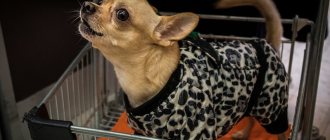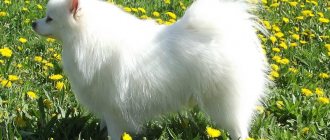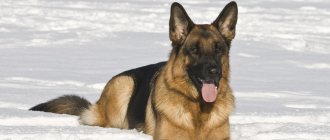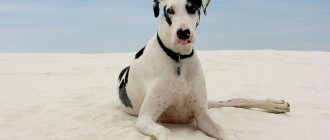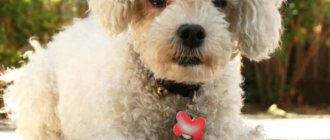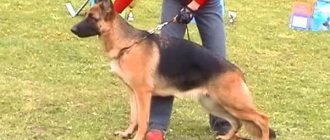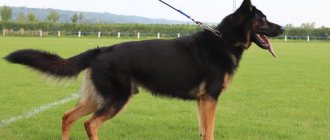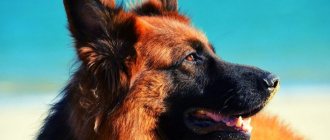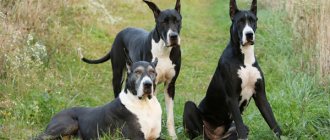At first glance, the Great Dane amazes with its size. This is a truly gigantic dog with an athletic build that looks quite intimidating. However, behind the stern appearance of the representatives of the breed hides a kind and affectionate dog that can become an excellent nanny for children. But before you get such a mighty good-natured dog, you should learn about its characteristics, nuances of care and education.
Breed characteristics
| Short description | |
| Origin: | Germany, 1888 |
| Conditions of detention: | Apartment/private house |
| Purpose: | Companion, can be used as bodyguards; sentinel characteristics are weakly expressed today |
| Color: | Straw (fawn), brindle; Black, marbled (white or gray base with black markings); Blue |
| Wool length: | Short, smooth, no undercoat |
| Adult dog size: | Height (at the withers): males 80 – 90 cm, females 72 – 84 cm Weight: from 30 to 50 kg |
| Average life expectancy: | 7-8 years |
| Walk: | 2-3 times a day |
| Physical activity needs: | High, active games, mostly running |
| Fédération Cynologique Internationale (FIC) classification: | Recognized by the FCI in 2012 Group 2/Section 2. Moloss (2.1. Mastiff) |
| Puppy price: | From 40 to 60 thousand rubles. |
History of the origin of the species
The starting point in the pedigree of the Great Dane is considered to be 1878, when Berlin dog breeders made a “fateful” decision to integrate numerous varieties of the breed into one. Led by the active “breeder” of that period, the German doctor of medicine Heinrich Bodinus, a committee was formed that adopted a resolution on the introduction of a single classification with the general name “Great Dane”.
Occupying the position of director of the Berlin Zoo, Bodinus and a team of like-minded people achieved amazing results in breeding many animals, including Great Danes. Guard dogs, greyhounds and mastiffs were used for selection. As a result, it was possible to significantly reduce the degree of aggressiveness of dogs, which until that moment were mainly used for hunting large animals.
In 1880, competitions were held in Berlin, organized by the National Great Dane Club (Deutscher Doggen-Club, NKND). The best representatives of the species participated in the finals of the competition. The exterior characteristics of the winners were recorded, and thus the NKND in 1888 approved the standards by which the Great Dane breed should be evaluated.
To date, three varieties of Great Danes have been formed, due to the following colors:
- Straw, brindle (black stripes against a background of red shades);
- Black, marble (white or gray background with black spots);
- Blue.
Crossbreeding of individuals of different colors is prohibited and leads to the disqualification of the dog.
The Great Dane was recognized by the FCI in 2012 and is included in group 2/section 2. Molosser (2.1. Mastiff). Performance has not been tested.
Interesting Facts
There are many interesting facts associated with representatives of this breed:
- Before the introduction of the official standard, the breed had several names: English, Great, Ulm, Great Dane, Boar or Hound dog.
- In the second half of the 19th century, Great Danes were declared the national breed of Germany.
- The modern breed standard has awarded the Great Dane the title of “Apollo of the canine world.”
- Great Danes were the property of aristocrats - they were kept in palaces as guards. Therefore, the breed is often called the Royal Dane.
- The dog named Scooby-Doo from the cartoon of the same name was a Great Dane. However, the character's cowardly nature has nothing in common with real representatives of the breed.
- The Great Dane Zeus from Michigan is listed in the Guinness Book of Records as the largest dog in the world. His height is almost 112 cm and his weight is more than 70 kg. He took over this title from the dog Giant George, who weighed 111 kg and had a height of 109.2 cm. Unfortunately, the giant died in August 2009.
- Fans of the breed were the first Chancellor of the German Empire, Otto von Bismarck, and Emperor Alexander II.
- In August 2022, the King of Thailand, Maha Vajiralongkorn, took under his protection and fed 13 Great Danes who were dying of hunger. The dogs belonged to a female breeder. She went bankrupt and had nothing to feed the animals.
Expert opinion
Leonid Rodin
Experienced dog breeder
Ask a Question
Many dogs were enlisted in military service and distinguished themselves in military affairs. But the story of the Great Dane, nicknamed Just Nuisance (“just hesitated”) - although he was given the name Pride at birth - stands out even against the background of these heroic stories. The dog became friends with the sailors from the cruiser Neptune and often lay down near the gangway, not allowing strangers on board. It was not possible to step over the huge dog, and the sailors rewarded the Great Dane with phrases like “he hesitated,” although they loved him and fed him. Later, he began to travel with the sailors to Cape Town and sometimes dragged friends who were tipsy on leave back to the ship. Since the railway workers did not want to transport a large stowaway dog, the base commander issued an order to enlist the Great Dane in the Royal Naval Service with the rank of sailor of the first class. And the first and last names in this document were designated Just Nuisance. The dog, like people, went to formations and on guard duty. Once, a four-legged sailor even saved the life of an aircraft mechanic who lost consciousness during an attack of malaria. Towards the end of his life, the Great Dane became addicted to alcohol, which is why the base commander wrote an appeal to the owners of drinking establishments. In it, the officer asked not to pour more than 6 glasses of beer for the dog, since it cannot refuse drinking on its own. The legendary sailor “Zakolebal” died in 1944 at the age of 7 and was buried in a military cemetery. And later a monument was erected in Simonstown: a huge, life-size Great Dane made of bronze stands on a piece of rock. At the dog’s feet lie a collar and a sailor’s cap. There is also a sign here: “Able seaman (sailor of the first article) Just Nuisance, 1937-1944.”
Distinctive features
The Great Dane has the following exterior characteristics:
- The head is large and long.
- The ears are pointed, slightly erect at the point of placement on the skull, the main part is hanging; sometimes they stop at will and can be erect.
- The forehead is flattened, high, wide.
- Cheekbones with pronounced muscles.
- The stop is pronounced; muzzle and skull are of equal length.
- The muzzle is rectangular in shape, voluminous.
- The jaws are powerful and wide.
- bite .
- The teeth are white, large, 42 in number; incisors do not protrude beyond the bite line.
- The eyes are medium-sized, almond-shaped; the setting is not wide; dark, merle-colored mastiffs can have light ones, and heterochromic ones are also found.
- The eyelids are dense.
- The nose is large, pronounced; black lobe.
- The nostrils are massive and open.
- The lips are tightly compressed and black; Great Danes of merle color may have light colors; The upper lip hangs down at an obtuse angle.
- The croup is powerful, with pronounced muscles, shortened.
- The neck is high, with a slight slope forward, strong, muscular, proportional.
- The withers are clearly defined and graceful.
- The back is short, the loin does not stand out, the line is straight.
- The chest is rectangular in shape with slightly rounded edges, deep, wide.
- The abdomen is slightly tucked.
- The shoulder blades are long and sloping.
- Forearms and wrists are straight, parallel, and muscular.
- The hind limbs are very strong, elastic, powerful.
- The shin is long.
- Paws are round in shape; fingers tightly adjacent to each other.
- The claws are short.
- The movements are smooth, slightly springy.
- The skin is elastic, pigmented.
- The coat is short, dense, there is no undercoat.
- The color is straw, brindle (black stripes on a background of red shades); black, marbled (white or gray base with black markings); blue.
- The tail is in the form of a saber, has a visible thickening at the croup, the seat is high, reaches the hock joint, in its natural state it is lowered, there is no hair.
How much does a Great Dane cost?
The cost for dogs with minor defects (improper placement of ears, deviations from acceptable colors) starts from 18-20 thousand rubles. Such animals have a good pedigree, but are not suitable for breeding or exhibition careers. Lower prices for Great Danes are justified by crossbreeding - mixing with other breeds. An adult mestizo can differ greatly from the standard, so saving on the purchase is pointless.
Breed and show-class animals cost at least 65 thousand rubles. Depending on the prestige of the nursery and pedigree, the price can reach more than 100 thousand rubles. When setting the final price, the seller includes all expenses incurred, so sterilized, microchipped and vaccinated animals always cost more than others.
Before purchasing, it is important to determine the purpose of getting a future pet. If you are looking for a companion dog, then do not overpay for the prestige of the class and choose a purebred pet with the “pet” classification.
Do you like the article? 0
Photo of an adult dog
Photos of puppies
Features of character and behavior
Exceptional strength and beauty, these dogs are also distinguished by their extraordinary physical strength . Character – calm, self-possessed, “royal”. These giants are an example of nobility and confidence in their strength. With a reasonable amount of self-confidence and a complete lack of aggressive behavior, Great Danes thrive alongside humans. The type of nervous system is strong, calm.
Great Danes exhibit a friendly nature and are known for their affection towards all family members. It is especially worth highlighting their reverent attitude towards children . They show some wariness towards strangers, but it takes little time to establish contact with strangers.
A high degree of controllability and trainability make them desirable pets. Dogs have a lively, active character and enjoy participating in active games with the owner and household members.
Despite their menacing appearance, modern Great Danes are absolutely harmless. Compliance and obedience are the main differences between dogs, which are universally recognized as the standard of beauty and grace. Owners of Great Danes note the affectionate, gentle temperament and patient nature of their pets. It is these characteristics that allow them to be considered excellent companions and “family” dogs. Dominant signs of behavior are not expressed.
Great Danes are very sociable, and for this reason they need daily contact with people.
Advantages
The Great Dane has a lot of advantages, among which the following features of the breed deserve special attention:
- Affectionate, flexible character.
- Calm, balanced psyche.
- Sociability, good-naturedness, desire to spend time in close proximity to the owner and other family members.
- Devotion, attentiveness, patience.
- High level of learning ability, intelligence.
- Absence of unreasonable barking and aggression towards strangers and pets.
- Suitable for inexperienced owners, it is an excellent companion, ready to accompany the owner.
- Minor shedding.
Flaws
The disadvantages of Great Danes are few and come down to the following:
- The large size and especially significant weight of the dog, which often becomes a problem if there are small children in the family, especially during active games with them;
- Increased consumption of products;
- Short lifespan;
- Needs constant contact with a person and is not suitable for people who do not have enough free time;
- Requires significant physical activity of high aerobic intensity;
- The place for sleeping and rest must correspond to the size of the dog; it is not suitable for keeping in an enclosure;
- Careful care and daily cleaning of the place of detention is required due to strong salivation.
Care and maintenance
The Great Dane does not require professional grooming. However, it must be regular. Great Danes require extra attention in caring for their teeth, ears and eyes.
- Bathing a dog is a complex and time-consuming procedure due to its large size and weight. For this reason, dry shampoos are preferred for this breed. The bathing procedure should not be carried out frequently; 2-3 times a year will be enough. When using regular shampoos and classic bathing, you must ensure that the products are thoroughly rinsed off, since the skin of Great Danes is highly sensitive. If the family lives in a private country house, the ideal option for bathing the Great Dane would be to wash it with a hose outside. Carrying out the procedure in frosty and rainy seasons is completely excluded. It should be borne in mind that Great Danes cannot tolerate humidity and try to avoid water procedures.
- The claws must be trimmed very short, to the edge of the sensitive area. Considering the weight of the dog and the discomfort they may experience when moving, the procedure should be carried out once a week, even with slight regrowth. Trimming can only be done using a guillotine nail clipper for large breed dogs. Additionally, it is necessary to check the animal’s paws daily and, if abrasions are detected on the pads and elbow joints, use protective creams.
- Teeth should be cleaned of plaque once a week. Cleansing of tartar and plaque, as well as treatment of identified inflammatory processes, is carried out in a veterinary clinic.
- The ears are one of the Great Dane’s weak points and require inspection and cleaning of accumulated dirt once every 2-3 days. It is especially important to conduct frequent examinations for dogs whose owners have not cropped their pets' ears. Failure to comply with this rule can lead to otitis media and complete hearing loss.
- eyes are the second weak point. It is advisable to visit a veterinarian once a month for a professional examination. Self-care involves daily monitoring by the owner for the presence of discharge and accumulations in the corners of the eyes. In case of clouding of the mucous membrane, you must immediately contact the clinic.
Additionally, it is necessary to take into account that Great Danes have increased salivation, and wet cleaning of the dog’s resting place should be done daily.
Nutrition
Considering the poor health of Great Danes, several rules must be followed in the diet of these dogs:
- Use only high-quality products or Premium+ food for large breeds;
- Change the diet gradually;
- In the summer, the amount of protein in the diet should be reduced.
There are also some peculiarities in the diet of a Great Dane puppy. In order for an adult dog to have good health, it is necessary:
- Monitor the presence of the required amount of calcium in foods, especially at the age of 2 to 8 months, when the skeleton is being formed; exceeding the dosage of 320 mg. per 1 kg of animal weight can lead to serious bone diseases, including osteochondrosis;
- Monitor weight gain; the optimal daily gain should not exceed 200 grams. in a day;
- Adjust the height of the feeding stand, increasing it as the puppy grows.
Great Dane puppies begin to feed themselves at 1.5 months, and the feeding scheme is as follows:
- Complementary foods are introduced at 3-4 weeks.
- The calorie content of a puppy's daily diet is 100 Kcal, for an adult dog - 50 Kcal.
- The number of feedings per day is up to 2 months – 6; up to 5 months – 4 with increasing volume of each feeding; up to 8 months – 3.
- At the age of 8 months, the puppy is transferred to 2 meals a day, with 45% of the daily requirement coming from morning feeding.
- The volume of each feeding is indicated on the packaging; exceeding the dosage is not allowed.
When considering types of feeding, it is better to choose dry food that contains the optimal ratio of essential minerals, vitamins and other nutrients.
The use of natural food is undesirable.
If, due to certain circumstances, it is not possible to feed your Great Dane with dry food, the following should be used in the diet:
- Meat (exclusively beef, no more than 700-800 grams daily for an adult dog);
- Fully cooked rice;
- Raw vegetables that do not contain allergens - carrots, pumpkin, zucchini, cucumbers.
Puppies are offered boiled meat . For adults, it is permissible to use raw meat in their diet, but no more than 2 times a week. You should completely EXCLUDE cereals (except rice), milk, onions, cabbage, eggplants, and tomatoes.
Health
The health of the Great Dane can hardly be called excellent. It requires constant monitoring by the owner. With proper care, increased attention during the growth and development of the puppy, compliance with the rules of feeding and walking, and regular visits to the veterinarian, Great Danes will be able to please their owners for up to 8 years.
Vaccinations
Great Danes have a sensitive immune system, so the vaccination schedule must be followed very strictly.
- The first vaccination against plague, hepatitis and other viral infections (enteritis, coronavirus) is carried out at 2 months . After vaccination, the puppy is quarantined for at least 12 days. Swimming is prohibited during this period. It is also necessary to exclude walking and contact with other animals. Poor tolerance of the first vaccination is noted - high fever, weakness, diarrhea.
- Revaccination is carried out after 3 weeks and also involves placing the puppy in quarantine.
- The rabies vaccine is given at 6 months , before teeth change.
- At 12 months , an adult dog is vaccinated with a complex vaccine and repeated annually.
Diseases
The main disease of Great Danes is related to the skeletal system. They are susceptible to hip and elbow dysplasia, like all large breeds.
In addition to problems with joints, the following diseases have been noted in veterinary practice in treating Great Danes:
- ophthalmological problems - ectropia, entropy, macroblepharia, cataracts, glaucoma;
- cardiac problems – aortic stenosis; cardiomyopathy;
- intestinal problems - flatulence;
- osteochondrosis, osteosarcoma;
- colds;
- hypothyroidism;
- allergic reactions;
- dermatitis, acne.
Walk
The intensity of walking a Great Dane differs depending on the age of the dog.
During the period of formation of the skeletal system, puppies should be limited in physical activity.
Starting from 8 months, during walks you should gradually include various exercises to maintain muscles. Preference should be given to aerobic exercise, alternating running, active games and fast walking. Special training exercises on stairs or crossbars, or jumping over barriers are not required.
An adult dog requires long walks, at least 2 times a day for 1.5-2 hours. It is allowed to reduce walking time in wet and cold seasons. During this period, it is recommended to use special waterproof and warm overalls. If possible, the ideal regime would be 3 daily walks for 1 hour each.
When walking Great Danes, it is recommended to alternate between different types of surfaces, including asphalt surfaces. The use of a muzzle in crowded places is advisable. Despite their good-natured nature and gentle disposition, dogs look dangerous, and passers-by can be scared by the mere sight of them.
Grooming
Keeping your Great Dane's short coat attractive is not particularly difficult. Care consists of cleaning with a brush or rubber glove 2-3 times a week. It is recommended to choose a soft brush so as not to damage the dog’s skin.
These dogs shed slightly, 2 times a year. During periods of shedding, combing out excess hair is carried out daily, using a brush or glove.
Breeding
A sexually mature female is a dog that has entered its first heat. Most often it occurs at 8-9 months, and the frequency is at least six months. A female can only be bred after reaching 22 months of age. Mating is best carried out under the supervision of a veterinarian or a specially trained instructor.
Very often, upon completion of the process, mating occurs in animals. It can last up to 60 minutes. During this period of time, it is forbidden to separate the female from the male by force; it is recommended to wait for natural separation.
Mating
In addition to the basic rules of mating, common to all large breeds of dogs (first mating after the third heat; upon reaching the age of 22-24 months ; mating of healthy individuals in the territory of a male dog in the morning on an empty stomach), there are special rules in breeding Great Danes.
These rules are established by the National Great Dane Club and relate, first of all, to the prohibition of mating individuals of different colors.
The following combinations of different types of knitting are acceptable:
- black and blue;
- fawn and brindle.
It is not recommended to breed a bitch more than once a year.
Photographer: Monica van der Maden
Nutrition
There are only 2 options for feeding a representative of the breed - professional and natural. The first involves feeding on dry food, and the second on human food. Each of them has both advantages and disadvantages.
If you chose the first option, then we strongly advise against buying cheap food without minerals for your dog. Its use by a dog can provoke the appearance of pathological processes in its body. Therefore, choose only a high-quality commercial product for her!
Regarding natural feeding. Your Great Dane puppy should receive carbohydrates, fiber, and protein on a regular basis. All these substances are found in cottage cheese, milk, raw meat and vegetables. We recommend feeding him at least 5 times a day.
Since an adult representative of the breed is very large, it requires quite a lot of food. Every day he must eat at least one and a half kilograms of food. You should also regularly pour clean water into his bowl (an energetic dog drinks a lot).
Key points in training
The Great Dane is a manageable, obedient dog and is easy to train. The non-conflict nature and high intelligence allow even inexperienced owners to cope with the dog. However, it is recommended to start training from an early age.
- Training a Great Dane does not require special knowledge, but it does require a significant level of endurance and patience from the owner. Given their size, these dogs are usually slow and, despite their intelligence, are slow to learn commands.
- The main point should be to accustom the dog to its place. Otherwise, one day you may find a huge Great Dane lazily lying on the owner’s bed. It is difficult to cope with such a giant on your own.
- Also, during the training process, it is necessary to focus on developing unquestioning obedience to the owner. Great Danes love outdoor games and can frighten passers-by and cause harm to other “participants in the game.”
Read about how to properly train a dog in the article: “Training a puppy: effective methods from dog handlers, learning commands at home.”
How to choose a puppy
Restrictions in breeding Great Danes determine the characteristics of the puppy of the breed and its main characteristics when choosing:
- The preferred age of the puppy is from 3 to 5 months;
- The croup should be dry and powerful; the stop is clearly defined; the upper lip is large; limbs parallel;
- The eyes are shiny;
- The puppy must be active and sociable.
The Great Dane is a divinely beautiful dog. A model of grace and elegance, he combines strength, endurance and a calm, balanced character. With these characteristics, the Great Dane is an ideal choice for any family.
5 / 5 ( 3 voices)
Health
On average, a Great Dane can live 6.5-7 years. We can say that nature has blessed these dogs with good health, but a predisposition to certain diseases is still observed:
- Problems with the gastrointestinal tract - bloating, volvulus, diarrhea.
- Hip dysplasia – accompanied by pain, lameness and immobility.
- Dermatitis is an inflammation of the skin.
- Lymphoma is a type of malignant cancer.
- Pyoderma - accompanied by an accumulation of pus. In the superficial form, the outer layers and hair follicles are affected. The deep form of pyoderma is accompanied by damage to the skin throughout its entire thickness.
- Cervical spine instability.
- Demodicosis is a parasitic disease. Caused by microscopic mites of the genus Demodex, which feed on skin and loose fiber.
- Congenital idiopathic megaesophagus is a disorder of contractility and dilatation of the esophagus.
- Osteochondrosis of the shoulder is a serious disease that affects the joints. Characterized by cartilage degeneration. It manifests itself as ossification of the cartilage with further destruction of the joint.
- Entropion, eversion of the eyelids - is eliminated surgically.
- Obesity.
It is easier to prevent a disease than to treat it later. Therefore, it is important to regularly undergo preventive examinations with your pet at a veterinary clinic. Timely vaccination and treatment against skin parasites are also mandatory.

